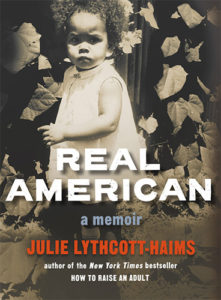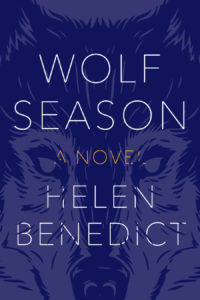5 Books Making News This Week: Collections, Translation, and Noir
Susan Sontag, Nicola Pugliese, Liska Jacobs, and More
The National Book Awards ceremony sparkles with Annie Proulx’s pithy remarks (“This is a Kafkaesque time”) and heartfelt acceptance speeches from Robin Benway, Frank Bidart, Masha Gessen and Jesmyn Ward. The writers on the National Book Award longlists, finalists and winners, pop down to read at the Miami Book Fair. Miami also offers newly minted Man Booker awardee George Saunders back-to-back with Booker of Bookers winner Salman Rushdie and brings Saunders on-stage to interview Joe Biden. At #VultureFestival in Los Angeles, crowds are wowed by the cast of Scandal (Kerry Washington take selfies with the audience) and by Roxane Gay reading as one of “the most daring voices in feminist writing today.” (“Listening to @rgay read ‘Magic Mike’ is the greatest 10 minutes of my life,” tweets one fan).
Julie Lythcott-Haims writes a “deeply affective memoir about growing up biracial,” Susan Sontag’s short stories offer another angle on the legendary author’s work; novelist Helen Benedict “follows the war home,” now in English: Italian journalist Nicola Pugliese’s Malacqua, first published in 1977, complete with a Calvino blurb; Liska Jacobs’s first novel is influenced by Jean Rhys.

Julie Lythcott-Haims, Real American
A former dean of freshman at Stanford University, Lythcott-Haims offers an unflinching memoir about growing up the daughter of a white British mother and a father who was raised under Jim Crow and became a leading physician. Publishers Weekly calls it “a bold, impassioned memoir that explores the emotional and cultural divide imposed by American racism on people of mixed race.”
Jenna Wortham (New York Times Book Review) points out:
What sets Lythcott-Haims’s book apart from others is that she doesn’t seem to be contextualizing the experience for white people—she’s working through the issues that she’s faced all her life, unpacking them in an effort to isolate and extract them, as a surgeon might inspect a cancerous cluster of cells before excision.
The most moving parts of Real American come when Lythcott-Haims stares unflinchingly at her own self-loathing, writing about the racist encounters of her childhood that convinced her from a young age that there was something inherently wrong with being black.
“Julie Lythcott-Haims has written a deeply affecting memoir about growing up biracial,” writes Heidi Stevens (Chicago Tribune). “It’s poetic and candid, and it dives into discussions we really ought to be having about race in America—past, present and future.”
George Anders (Forbes) concludes, “What Julie shares in Real American is a story that will connect with anyone whose mothers or fathers came of age in harsher circumstances. We’re torn between celebrating the raw realities of their journeys—or hiding from them. She’s managed to fit the whole messy, beautiful truth between two covers.”

Susan Sontag, Debriefing: Selected Stories, ed. by Ben Taylor
Eight stories published in 1977 as I, etcetera, plus three new stories, add up to a refreshingly updated look at Sontag’s legacy.
“What do we learn about great intellectual Susan Sontag from reading these stories?” asks Josephine Livingstone (The New Republic). “In Debriefing we see a writer who was confident enough, and knew herself well enough, to try and try again, and develop when she failed.”
Ann Levin (Associated Press) points out some of her favorites in the collection:
The autobiographical “Pilgrimage” may be worth the price of the book alone for its earnest, nerdy account of Sontag’s visit at age 14—yes, 14—to see her literary hero, Thomas Mann, who was then living in exile in Southern California.
Another gem, “The Way We Live Now,” first appeared in 1986, at the height of the AIDS crisis. Stitched together from snippets of conversation among friends of a man recently diagnosed with HIV, the story perfectly captures their vain, often self-serving concern for him, as well as the anxiety and ignorance that surrounded the disease in that era.
Christian Lorentzen (Vulture) concludes:
Sontag was an avowed fan of Donald Barthelme, and his influence is clear, especially in “American Spirits,” a pastiche of the love life of Miss Flatface, who hears the voices of the ghosts of famous Americans. “Baby” narrates the life of a baby-boomer child in the voices of parents consulting with a doctor in the course of daily visits that accelerate years at a time. “Dummy” imagines a corporate stiff replacing himself with clones to escape “the problems of this one poor short life that was allotted me.” Any of these stories could fit neatly in anthology of the period. Without bylines, you wouldn’t necessarily peg them to Susan Sontag, but you can hear their echoes all around today, in the fiction of Lydia Davis and Lynne Tillman and Deb Olin Unferth, and they’ll keep ringing as long there are those for whom received forms and straitened ways of being a writer are never enough.

Helen Benedict, Wolf Season
The second in a projected trilogy of novels about the impact of the war in Iraq on women’ lives explores the impact on three families in the wake of a hurricane. The starred Library Journal review concludes, “In a book that deserves the widest attention, Benedict “follows the war home,” engaging readers with an insightful story right up until the gut-wrenching conclusion.”
Wendy Smith (Publishers Weekly) calls the novel “a searing portrait of the lasting impact of the war in Iraq on three women in a small upstate New York community: Naema, an Iraqi refugee; Beth, wife of a Marine; and Rin, an angry American veteran who tends her blind daughter Juney and a trio of wolves on a remote, ramshackle farm.”
Jenny Ferguson (Washington Independent Review of Books) concludes:
From its early pages, it’s hard to tell that this is a tragedy playing out. But it is indeed a tragedy, one that explores war’s effects far beyond the battlefield. Told with honesty and empathy, Wolf Season is a contemporary tale about how the war always comes home.
All three of Benedict’s protagonists “bear the burdens of war brought home, their lives and struggles intersecting after the hurricane,” notes Steve Weiberg (Kansas City Star). “Benedict drew from interviews she had conducted with dozens of female veterans over a three-year period for a revealing nonfiction book, The Lonely Soldier: The Private War of Women Serving in Iraq, released in 2009. A groundbreaking examination of the abuse of thousands of women in the U.S. military, it inspired the Oscar-nominated documentary “The Invisible War” and prompted a class-action suit against former defense secretaries Donald Rumsfeld and Robert Gates.”

Nicola Pugliese, Malacqua: Four Days of Rain in the City of Naples, Waiting for the Occurrence of an Extraordinary Event, trans. Shaun Whiteside
Pugliese, a long-time journalist for Roma who died in 2012, wrote his only novel in the 1970s. It’s now back in print, translated by Shaun Whiteside, complete with the blurb by Italo Calvino: “This is a book with a meaning and a force and a message.”
Peter Mitchell (Asymptote) explains:
Nicola Pugliese’s Malacqua, a strange and visionary novel about an apparently endless rainstorm in Naples, predates this new significance of floods, but the baroque weirdness of its apocalyptic imagination has a lot to tell us nonetheless. It also comes to Anglophone readers as something of an enigma. Pugliese was a journalist who lived and worked most of his life in Naples; he published Malacqua in 1977. It sold out in a couple of days. Pugliese forbade any reprints or reissues, withdrew the whole thing from publication, and died, in 2012, without having published any more fiction. Since his ban on further publication ends with his death, And Other Stories have seized on the book as a more-or-less forgotten classic of melancholy Italian postmodernism. The fact that Malacqua has been effectively buried since its first appearance makes it even more difficult not to read it as an artifact of Italy’s long, ugly crisis of the 1970s, reanimated with impeccable timing for our own widening gyre.
Toby Lichtig (Wall Street Journal) calls the novel “a lyrical, caustic and highly fantastical imagining of a Naples beset by a biblical deluge, accompanied by a variety of peculiar phenomenon . . . dolls speak and pocket money sings . . . ”
Vol.1 Brooklyn includes Malaqua in its November recommended list: “We are wholly up for novels about journalists investigating surreal happenings in cities sliding into madness or decay.”

Liska Jacobs, Catalina
Jacobs’s first novel was shaped in part by her job at the Getty Research Institute in Los Angeles, where she worked in an office with views of Catalina Island on a clear day. “I’m probably most influenced by Jean Rhys’s protagonists,” Jacobs tells Electric Literature’s Heather Scott Partington. “Specifically, for this book, Sasha Jensen in Good Morning Midnight. Like Sasha, Elsa is self-destructive and spiraling.”
“Her book is so rooted in place—in the high-thread-count sheets of the Miramar in Santa Monica and the nearby shores of Catalina Island—that her vivid, evocative prose feels backlit by the glare off the sea,” writes Agatha French (Los Angeles Times). ”It’s California that her narrator, Elsa, returns to after the end of an affair and an untidy firing from the Museum of Modern Art in New York, and her reckless, compulsively readable unraveling takes place on Catalina Island during a tense reunion with an ensemble cast of old friends.”
Noah Sanders (East Bay Review) is disappointed:
Expectation is what dooms Catalina for me as a reviewer. The book trumpets itself as an “LA Noir”—a seedy, white heat sort of genre that proclaims murder and sordidness in equal measures. And yes, Liska Jacob’s book is a tar-black tale of adulthood gone wrong, but it never reaches the fever pitch of what I, or any fan of the genre, would deem “noir.” Instead Catalina bends towards “emotional noir”—all the inner psychological weight and concurrent desperation, the shitty decision-making and save-your-own-ass motivation, without the violent climax. Liska Jacobs propels the reader forward with pithy descriptions and a main character with a set of morals burnt by rejection and rampant pill popping, upping the ante by surrounding her with a cast of supporting roles equally damaged by the inevitable emotional traumas of adulthood. Yet the build—and Jacobs has an enviable skill at creating dramatic tension—amounts to almost nothing, no big finale, no grisly death, just bad people doing bad things.
Lisa Shea (Elle) is a fan: “If noir lit with a feminist twist appeals to you, treat yourself to Liska Jacobs’s magnetic debut novel about a young woman’s dramatic undoing after being fired from her New York City museum job following an affair with her boss.”




















